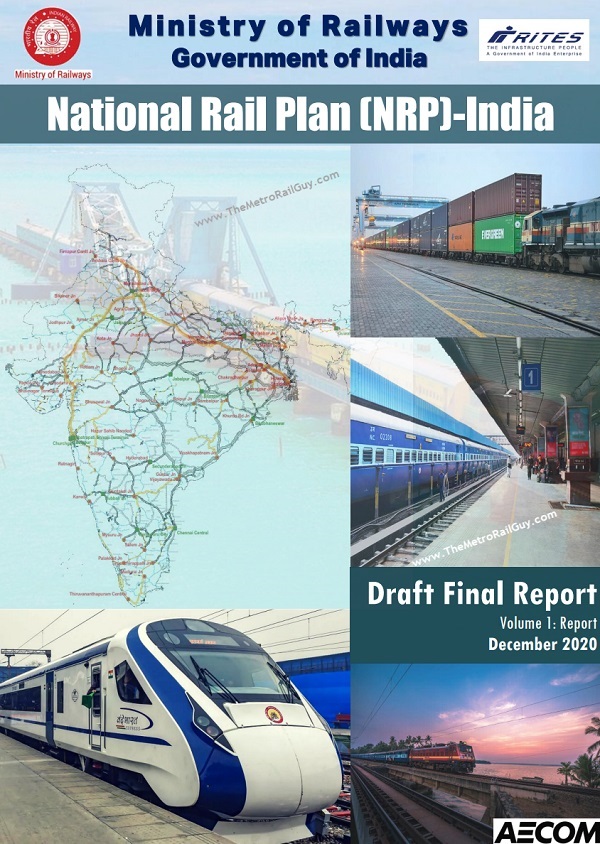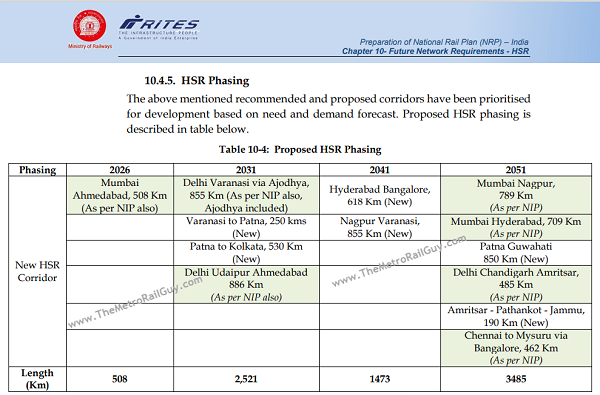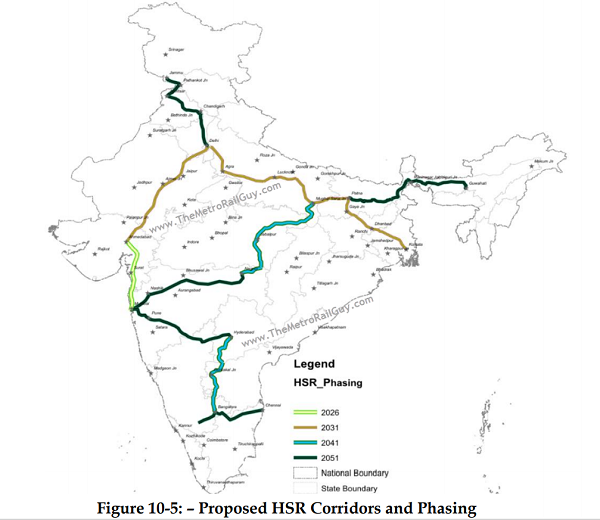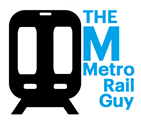National Rail Plan Drafted for India’s High Speed Rail Projects
India’s Ministry of Railways on Friday published a draft of the National Rail Plan (NRP) policy document with a primary aim to create capacity, increase the Indian Railways’ modal share from 26% of all transport to 45% by 2030, which in turn would cater to growth in demand right up to 2050.
The 1101 page plan was developed by RITES – AECOM JV and can be accessed here (warning: 61 MB) with timelines and strategies for developing and upgrading the Indian Railways’ main-line, high-speed rail (HSR) system and dedicated freight corridors (DFCs).
To me it’s merely a recommendation document and ultimately the incumbent government in power will have to decide which projects it wants to pursue based on funding, ridership projections, financial viability and other economic considerations, so I’d recommend everyone to not take it too seriously.
To give a little background, RITES – AECOM JV started preparing the report back in December 2018 and the Ministry of Railways plans to finalize it in January 2021 after taking recommendations from all stakeholders.

Within this post I plan to concentrate on the High Speed Rail project’s development (approx. total = 7897 km) mentioned within the document.
Straight off the bat – the timelines mentioned in it are odd and not aligned with what the National High Speed Rail Corporation (NHSRCL) is already pursuing. For example, it suggests developing 6 corridors (eg. Mumbai – Nagpur HSR) with a target of 2051, but the NHSRCL has over the past 6 months already set into motion the development of their detailed project reports (DPRs) by awarding contracts for survey & traffic study work.
Let’s first take a look at the plan objectives shared by the government’s Press Information Bureau:
Plan Objectives
- To create capacity ahead of demand by 2030, which in turn would cater to growth in demand right up to 2050 and also increase the modal share of Railways from 27% currently to 45% in freight by 2030 as part of a national commitment to reduce Carbon emission and to continue to sustain it. Net Zero Carbon emission by 2030.
- To assess the actual demand in freight and passenger sectors, a yearlong survey was conducted over hundred representative locations by survey teams spread all over the country.
- Forecast growth of traffic in both freight and passenger year on year up to 2030 and on a decadal basis up to 2050.
- Formulate strategies based on both operational capacities and commercial policy initiatives to increase modal share of the Railways in freight to 45% by 2030.
- Reduce transit time of freight substantially by increasing average speed of freight trains from present 22Kmph to 50Kmph.
- Reduce overall cost of Rail transportation by nearly 30% and pass on the benefits to the customers.
- Map the growth in demand on the Indian Railway route map and simulate the capacity behaviour of the network in future.
- Based on above simulation identify infrastructural bottlenecks that would arise in future with growth in demand.
- Select projects along with appropriate technology in both track work, signalling and rolling stock to mitigate these bottlenecks well in advance.
Within the National Rail Plan, “Vision 2024” has been launched for accelerated implementation of certain critical projects by 2024 such as 100% electrification, multitracking of congested routes, upgradation of speed to 160 kmph on Delhi-Howrah and Delhi-Mumbai routes, upgradation of speed to 130 kmph on all other Golden Quadrilateral-Golden Diagonal (GQ/GD) routes and elimination of all level crossings on all GQ/GD routes.
High Speed Rail Timeline (Phasing)
India’s National Infrastructure Pipeline (NIP) has already set into the motion the following 6 new high speed rail corridors in addition to the Mumbai – Ahmedabad HSR (Bullet Train) which will soon be under construction. I’ve linked them up to their dedicated information pages which includes basic route information with a list of stations, bidding status and contractor information.
- Delhi – Agra – Lucknow – Varanasi
- Delhi – Chandigarh – Amritsar
- Delhi – Udaipur – Ahmedabad
- Mumbai – Nasik – Nagpur
- Mumbai – Hyderabad
- Chennai – Mysuru
In fact earlier this month, NHSRCL invited bids for 2 survey related packages encompassing the Varanasi – Howrah line as well, taking the number of corridors in the proposal stage to 7.
The NRP report proposes the following 13 corridors in total (existing and extensions) with a combined total of 7897 km for enhancing HSR outreach and providing connectivity to other towns en route.
| Year | Corridor & Approx. Length |
| 2026 | Mumbai – Ahmedabad (508 km) |
| 2031 | Delhi – Ayodhya – Varanasi (855 km) |
| 2031 | Delhi – Ahmedabad (886 km) |
| 2031 | Varanasi – Patna (250 km) |
| 2031 | Patna – Kolkata (530 km) |
| 2041 | Hyderabad – Bangalore (618 km) |
| 2041 | Nagpur – Varanasi (855 km) |
| 2051 | Mumbai – Nagpur (789 km) |
| 2051 | Mumbai – Hyderabad (709 km) |
| 2051 | Patna – Guwahati (850 km) |
| 2051 | Delhi – Chandigarh – Amritsar (485 km) |
| 2051 | Amritsar – Pathankot – Jammu (190 km) |
| 2051 | Chennai – Bangalore – Mysuru (462 km) |

High Speed Rail Development Suggestions
The NRP report highlights the following suggestions for new corridors with an aim to meet growing passenger demand, and to optimize high-speed rail connectivity between major cities / commercial / economic centres.
The below information from the NRP report has been posted verbatim (not my thoughts):
- Delhi- Chandigarh- Ludhiana – Jalandhar- Amritsar HSR Corridor is recommended to be extended to Jammu via Pathankot for enhancing regional connectivity and for giving economic boost to the Jammu and Pathankot Region. It will cater to the religious tourism potential of Vaishno Devi Shrine and other places.
- Delhi- Agra- Kanpur- Lucknow- Varanasi- HSR corridor is recommended to route via Ayodhya due to Religious Tourism Potential.
- Delhi- Agra- Kanpur- Lucknow- Varanasi- HSR corridor is also recommended to be extended to connect Patna and Kolkata.
- Additional HSR Line from Patna to Guwahati via Katihar and New Jalpaiguri thereby connecting Guwahati with Delhi Varanasi Kolkata HSR Corridor.
- Additional HSR Line between Hyderabad and Bengaluru by extending
Mumbai Hyderabad HSR Line. This shall connect Mumbai with Chennai and also will bring North India from Jammu – Amritsar – Delhi – Jaipur – Ahmedabad – Mumbai – Hyderabad – Bengaluru – Chennai on HSR corridor and all the major towns of North, West and South India shall be connected with 1 HSR Corridor. This will help in boosting the regional economy. - Additional HSR line is proposed between Nagpur and Varanasi by extending the Mumbai – Nashik – Nagpur HSR Corridor. This shall connect Mumbai with Varanasi which will further connect with Delhi – Varanasi – Patna – Guwahati HSR corridor.

Concluding thoughts – the report was prepared by consultants and doesn’t take into account ongoing development for 7 new corridors by NHSRCL. We’ll have to wait and see if the final report does.
Ultimately the incumbent government, both central and state, at power will decide the fate of the lines and their sequencing for construction. I certainly do not see a Nagpur – Varanasi line getting prioritized for execution over the more lucrative Delhi – Chandigarh – Amritsar or Chennai – Bengaluru – Mysuru lines that have a much higher ridership potential.
It’s good to have a guiding plan in place and this is a good start at generating conversation, but I’d like to see NHSRCL clarifying if they intend to adopt this plan or come up with their own masterplan – something which I’d expect would be grounded in reality and can be fine-tuned as the country marches ahead.
For more updates, check out the High Speed Rail section of The Metro Rail Guy!
– TMRG




It seems they are partially focusing on tourism. It would be ideal to first cover quadrilateral routes which are high on economic activity.
True. Large detours to connect Ayodhya and Gaya makes the Varanasi – Kolkata line look more like a pilgrimage route.
Well, it caters for normal commuters as well as pilgrim commuters. This will help increase ridership with less than 15 minutes of detour. I think it makes sense..
2051? What a joke. I will be 80 by then. This needs a rethought.
Makes no sense to not connect the 3 main port cities of the east coast
I think we are missing the point of bullet trains here the well paying chunk of domestic business destination must be the first to be connected which then should be followed by tourisms and religious places. Plus no planning seems to been done for east coast of the country and for northeast(its going to be tricky but not impossible). I hope we start work on Mumbai-Nagpur and Mysuru-Chennai first.
They most have added Rajgir as well as Nalanda.This both are tourist Rajgir need better connectivity because their is no regular buses to Rajgir.As the future’of Rajgir is great with Cyber city under-construction, Rajgir International Cricket Stadium,zoo safari and also an international airport.
There must be a station for Rajgir and Nalanda as these both are tourist city.Rajgir has an international importance.
Disappointing! That’s the crux of this plan.
Where are the major trunk routes ?!
Bangalore-Chennai, Pune-Hyderabad, Dhanbad-Kolkata
All forgotten !
Chennai-Mysuru route is proposed to go via Bengaluru, so that’s covered.
Blr-Chennai (in Chennai-Mysuru), Pune-Had, Dhanbad-Kolkata (in Varanasi-Kolkata) are all covered. Only the timelines are a bit strange
The Chennai-Bengaluru-Mysuru line must be extended to West Coast (Mangaluru) in the strategic interests of the country. This will be a good fast line across the Southern Peninsula connecting the Coasts.
Personally, I would have preferred a distinction between bullet train routes (upto 350 kmph) and high speed train routes (upto 200 kmph). The latter would likely be filled up by the new private sector trains that is being planned and ideal for inter-city trunks with a maximum distance of up to 400 km while the bullet trains catered to long distance, over 500 km.
A lot of cities could be covered within this for high speed inter-city: Mumbai-Pune, Mumbai-Nashik, Mumbai-Surat/Baroda, Baroda-Ahmedabad, Delhi-Jaipur, Jaipur-Jodhpur, Delhi-Lucknow, Hyderabad-Bangalore, Bangalore-Chennai, Chennai-Coimbatore, Delhi-Bhopal, etc.
That would leave the really long distance trunks like Delhi-Mumbai, Delhi-Bangalore, Delhi-Chennai, Delhi-Kolkata, Kolkata-Chennai, Kolkata-Mumbai, and Mumbai-Bangalore-Chennai for the bullet trains.
railways is agin messing up with nhsrcl. just the same way it did with Delhi metro earlier.
timelines in this report are nothing but crap
This is a joke, why 2051, it takes too much time to reach Guwahati, we need faster routes today not in 2051, eventually by 2051 most of railways would be private, so the government wants something else not this, so it might be a wastage of time to read this.
Delivery Periods need to be curtailed by 50 to 60 % to make the Rail Plan Useful.
Capacity and Capability of Project Units/ PSEs with Enabling Propmt Approvals Regime and along with Delegation of Authority with Full Faith and Trust on the Team Required so that the Projects are Commissioned by 2030.
Thanks for pointing this is FOR the government and not BY the government. I had a breakdown on Friday seeing this hot mess
The document seems to be full of contradictions.
As mentioned in “High Speed Rail Development Suggestions”:
Additional HSR Line between Hyderabad and Bengaluru by extending
Mumbai Hyderabad HSR Line
But, the Hyd-Blr will come before the Mum-Hyd line, so how is this an extension? Similar errors at a couple of other places 😐
I think the timelines are completely messed up..
Having read chapter-10 of the report, my take:
This report will add to cacophony of reports/plans submitted by other commissions, committees & consultants – perpetuation of more confusion by the techno-bureaucratic maze of Indian Railways.
There is a sound entity created for the purpose of HSR, called NSHRCL. So, why don’t they let NHSRCL prepare the plan and phasing of HSR network for the country, the way DMRC did for Delhi Metro.
Don’t know why RITES is meddling around and proposing plans for HSR. Prior NHSRCL, there was another entity named HSRCIL (http://hsrc.in/projects.html), a subsidiary of RVNL – which was created to study the HSR networks. Check the link. Wondering whether this entity HSRCIL is still active?…should be disbanded and its website be shut down.
What’s the basis of proposing Nagpur-Varanasi? Why not Nagpur-Bhopal-Agra instead? Have they done traffic studies? Whimsical recommendations, not technical/logical basis provided…
The IR nincompoops need to realise that HSR is a completely different ball game – which need a totally different mind-set to plan, execute and operate the HSR network. It cannot be done by old/lethargic ways of IR (read RITES, RVNL and the like). Need new breed (new blood) of Engineers – with right mind-set, competence & work-culture – to plan/design/run the HSR. NHSRCL shows sound beginning – let’s put our faith in NHSRCL’s planning and ignore the rest..
The best one should do about this report is to ignore it and wait for NHSRCL’s HSR DPRs to come out.
…overall a poor job. There are typographical errors too in the report (even list numbering is not correct at some places) …can’t imagine how come the ministry’s babus put up a report in public domain without proper proof-reading…
PS: The above thoughts are only meant for chapter-10 of the report.
———————————————————————————————————-
The govt. announced major reforms for Rail Technocracy/Bureaucracy in Dec. 2019, TMRG – any idea where things stand now? What’s the status of the so-called ‘Rail Development Authority’? Have they managed to create the Rolling Stock’s company?
Is Modiji, Prime Minister of India or Pilgrimage Minister
Prachar Minister
What’s about Completing Diamond Quadrilateral by 2030? Was it a joke? 🤔
gourment makes plan only 2051 many of us will die ,see mumbai ahemdabad first was complete in 2021 but ,the corridor will be complete in 2030
In this world wats important. If food, clothing, shelter, job & health care are more needed to b focussed or bullet trains, HSRL, Metrolite, pods, virgin hyperloop.
One can decide if v wanna destroy nature by having too many transport systems or satisfy with whatever existing(Flights, local & out station trains, buses, cabs, 2 & 3 wheelers bicycles etc…
Lets focus on saving humanity(food, shelter, clothing, jobs & efficient & affordable health care sytem) rather focussing on rich loan funding, nature destructing projects.
The only way people can have the above (food, clothing etc.) is by having enough jobs. For jobs, the supply chains, communication and transport have to be excellent so that we can compete with the rest of the world (and good laws more importantly).
We cannot keep throwing free food, medicine etc to people, we do not have enough tax collection. Even to increase the tax collection, people will need to have jobs and spend more, which comes back to the above. So, HSR (and any other infra project) is a very welcome step.
BTW, the above thought process is capitalist, not communist or socialist. You may beg to differ..
Subject: Extension of Railway Track in Himachal Pradesh
Respected sir,
It is submitted that the government is executing vast projects in J and K, Uttarakhand and other parts of the country making long tunnels in hilly areas but in Himachal Pradesh the railway development is very slow except in Manali,kullu etc.
The Himachal Express train is running from Delhi Junction to Amb, Daulatpur Chowk and terminate there. Mostly this HP state is a residential state for Defence service personnel.
My suggestion is that the Broad gauge terminating at Amb(Una) but further there is no train. From Amb, the government can plan to connect Palampur station through narrow gauge which is a shorter distance.
The Palampur under district Kangra is developing very fast and the peoples are shifted from plains to Hills. Although Palampur station is already connected from Pathankot through narrow gauge running from Pathankot to Joginder Nagar LINE which is 120 km but it take more than 6 hours to reach Palampur.
The connection from Amb(Una) to Palampur through narrow gauge just like from Kalka to Shimla will have a effect of development in multiple times and it is the shortest route and takes less time from Delhi in comparison to Delhi Pathankot longest trunk line which is heavily booked and one cant’s get accomodation in these trains.
The shortest distance may be seen by aerial survey and the immediate action may be taken for starting the work in parts i.e after every one kilometre. By this, it is expected that the work may be completed within 2 to 3 years time.
In view of the above, it is humbly requested that immediate action for its planning and execution on ground may be taken on WAR FOOTINGS for the progress of our HP State which is bordering J&K and China on Eastern side.
For this act of kindness and taking keen interest in this project will not be forgotten for the centuries to come by the residents of HP.
They should have to add gaya station
They should have to add gaya station and gaya is also a tourist pilgrimage city and also has a international airport